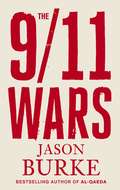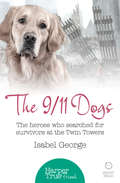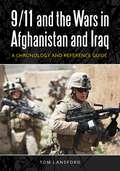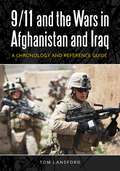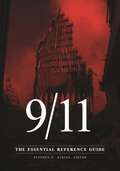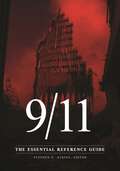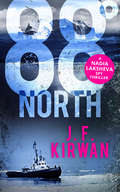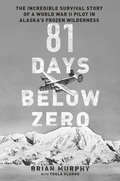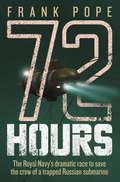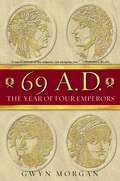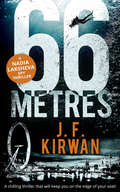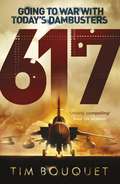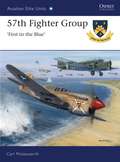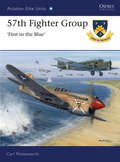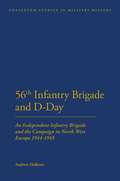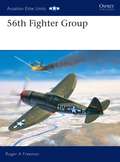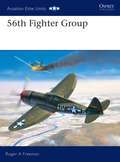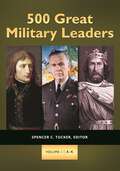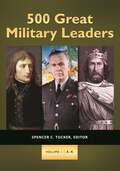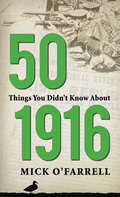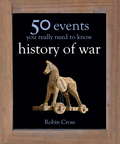- Table View
- List View
The 9/11 Wars
by Jason BurkeDAILY TELEGRAPH, ECONOMIST AND INDEPENDENT BOOKS OF THE YEARThroughout the 1990s a vast conflict was brewing. The storm broke on September 11th 2001. Since then much of the world has seen invasions, bombings, battles and riots. Hundreds of thousands of people have died. Jason Burke, a first-hand witness of many of the conflict's key moments, has written the definitive account of its course in his acclaimed book The 9/11 Wars.At once investigation, reportage and contemporary history, The 9/11 Wars is an essential book for understanding the dangerous and unstable twenty-first century. Whether reporting on the riots in France or the attack on Mumbai, suicide bombers in Iraq or British troops fighting in Helmand, Jason Burke tells the story of a world that changed forever when the hijacked planes flew out of the brilliant blue sky above Manhattan on September 11th.Reviews:'The best overview of the 9/11 decade so far in print' Economist'A magisterial history of the last decade ... The long patient sentences of The 9/11 Wars are suffused with the melancholy of a man who has learned a great deal from long exposure to atrocity and folly' Pankaj Mishra, Guardian'The 9/11 Wars warrants great respect' Metro'Pacy, well-researched, and packed with telling anecdotes, this book's strength is in its detailed, balanced overview ... At a time when there are more books out on terrorism than ever before ... this is likely to be among the best' Sunday Telegraph'[Burke] is one of the most respected and experienced foreign correspondents in the business ... A major authority on the politics and organisation of Islamic extremism and ... a talented writer with the rare gift of joining effortless prose to challenging scholarship ... [The 9/11 Wars] is a magnificent achievement' Irish Times'A reader wanting a more dispassionate survey of how 9/11, and the response to it, may have shaped parts of the world will do no better than invest in [this] brilliant book' David Aaronovitch, The Times'This remarkably balanced, well-sourced and very well-written book ... will be turned to in the future ... [Burke] has demonstrated impressive expertise as a historian who has had the advantage of having been present on many of the battlefields he describes' Andrew Roberts, Evening Standard'[A] lucid, sane account ... taut, careful reporting ... Remarkable' Scotsman'Potent ... journalism of a high order. Like all good reporters, Burke is something of a scholar, drawing meticulously on interview notes years old, and on extensive background reading. He excels, too, in describing the experiences of ordinary Muslims; such insights make this book essential for understanding the past decade' Sunday TimesAbout the author:Jason Burke is the South Asia correspondent for the Guardian. He has reported around the world for both the Guardian and the Observer. He is the author of two other widely praised books, both published by Penguin: Al-Qaeda and On the Road to Kandahar. He lives in New Delhi.
The 9/11 Dogs: The Heroes Who Searched For Survivors At The Twin Towers (HarperTrue Friend – A Short Read)
by Isabel GeorgeMeet the dogs who searched for life amongst the ruins of the Twin Towers.
9/11 and the Wars in Afghanistan and Iraq: A Chronology and Reference Guide
by Tom LansfordThis book analyzes the complex causes and effects of the September 11, 2001, terrorist attacks both domestically and internationally, and examines the subsequent wars in Afghanistan and Iraq.The first decade of the 21st century witnessed a watershed of political, economic, diplomatic, and military change as a direct result of the events of September 11, 2001. Through narrative chapters, a chronology of events, biographical sketches of principal players, and annotated primary documents, author Tom Lansford documents the domestic impact of the terrorist attacks that stunned the world as well as the subsequent "war on terror" and the invasions and occupations of Afghanistan and Iraq.9/11 and the Wars in Afghanistan and Iraq: A Chronology and Reference Guide explores the origins and aftermath of the September 11, 2001, terrorist attacks in both the domestic and international contexts. It addresses the rise of global terrorism and the concurrent histories of Afghanistan, Iraq, and the broader Middle East, as well as the interaction of the United States with the region. Events, trends, groups, and individual players are examined as part of the broader historical context, allowing readers to see the connections between these various elements.
9/11 and the Wars in Afghanistan and Iraq: A Chronology and Reference Guide
by Tom LansfordThis book analyzes the complex causes and effects of the September 11, 2001, terrorist attacks both domestically and internationally, and examines the subsequent wars in Afghanistan and Iraq.The first decade of the 21st century witnessed a watershed of political, economic, diplomatic, and military change as a direct result of the events of September 11, 2001. Through narrative chapters, a chronology of events, biographical sketches of principal players, and annotated primary documents, author Tom Lansford documents the domestic impact of the terrorist attacks that stunned the world as well as the subsequent "war on terror" and the invasions and occupations of Afghanistan and Iraq.9/11 and the Wars in Afghanistan and Iraq: A Chronology and Reference Guide explores the origins and aftermath of the September 11, 2001, terrorist attacks in both the domestic and international contexts. It addresses the rise of global terrorism and the concurrent histories of Afghanistan, Iraq, and the broader Middle East, as well as the interaction of the United States with the region. Events, trends, groups, and individual players are examined as part of the broader historical context, allowing readers to see the connections between these various elements.
9/11: The Essential Reference Guide
by Stephen E. AtkinsThis important reference work is essential reading for students attempting to understand the horrific events of September 11, 2001, and the impact the devastating terrorist attack had on the United States.The World Trade Center and Pentagon attacks of September 11, 2001, continue to have a major impact on the United States. The deadliest day in modern U.S. history reverberates in numerous ways, as its influence is felt in such areas as civil liberties, foreign policy, immigration, and presidential powers. This essential guide features illuminating essays written by top scholars that discuss in detail the impact of 9/11 in these critical areas, as well as how it has changed the lives of Muslim Americans in the 21st century.The core of this reference work are the dozens of A–Z entries on all of the key groups, individuals, and events surrounding the 9/11 terrorist attacks, including the first responders, the heroes of United Airlines Flight 93, the Osama bin Laden raid, and the 9/11 Commission Report. In addition, the book offers a carefully curated group of primary source documents essential to understanding the 9/11 attacks. The book concludes with a detailed chronology and an annotated bibliography.
9/11: The Essential Reference Guide
by Stephen E. AtkinsThis important reference work is essential reading for students attempting to understand the horrific events of September 11, 2001, and the impact the devastating terrorist attack had on the United States.The World Trade Center and Pentagon attacks of September 11, 2001, continue to have a major impact on the United States. The deadliest day in modern U.S. history reverberates in numerous ways, as its influence is felt in such areas as civil liberties, foreign policy, immigration, and presidential powers. This essential guide features illuminating essays written by top scholars that discuss in detail the impact of 9/11 in these critical areas, as well as how it has changed the lives of Muslim Americans in the 21st century.The core of this reference work are the dozens of A–Z entries on all of the key groups, individuals, and events surrounding the 9/11 terrorist attacks, including the first responders, the heroes of United Airlines Flight 93, the Osama bin Laden raid, and the 9/11 Commission Report. In addition, the book offers a carefully curated group of primary source documents essential to understanding the 9/11 attacks. The book concludes with a detailed chronology and an annotated bibliography.
88° North (Nadia Laksheva Spy Thriller Series #3)
by J.F. Kirwan‘Nadia is a heroine readers are bound to fall hard for!’ – BestThrillers.com The deadliest kind of assassin is one who is already dying…
81 Days Below Zero: The Incredible Survival Story Of A World War Ii Pilot In Alaska's Frozen Wilderness
by Brian Murphy"A riveting...saga of survival against formidable odds" (Washington Post) about one man who survived a World War II plane crash in Alaska's harsh Yukon territory Shortly before Christmas in 1943, five Army aviators left Alaska's Ladd Field on a routine flight to test their hastily retrofitted B-24 Liberator in harsh winter conditions. The mission ended in a crash that claimed all but one-Leon Crane, a city kid from Philadelphia with no wilderness experience. With little more than a parachute for cover and an old Boy Scout knife in his pocket, Crane now found himself alone in subzero temperatures. Crane knew, as did the Ladd Field crews who searched unsuccessfully for the crash site, that his chance of survival dropped swiftly with each passing day. But Crane did find a way to stay alive in the grip of the Yukon winter for nearly twelve weeks and, amazingly, walked out of the ordeal intact. 81 Days Below Zero recounts, for the first time, the full story of Crane's remarkable saga. In a drama of staggering resolve and moments of phenomenal luck, Crane learned to survive in the Yukon's unforgiving wilds. His is a tale of the capacity to endure extreme conditions, intense loneliness, and flashes of raw terror-and emerge stronger than before.
75 years of the Lockheed Martin Skunk Works
by James C. GoodallThe Lockheed Martin Skunk Works was founded in the summer of 1943 to develop a jet-powered high-altitude interceptor for the USAAF, and ever since it has been at the forefront of technological development in the world of aviation. From the XP-80 to the U-2, SR-71, F-117, F-22 and now the F-35, the Skunk Works team has designed aircraft that are the pinnacle of innovation and performance.75 years of the Lockheed Martin Skunk Works takes us through the history of this legendary facility from its foundation at the height of World War II under the talented engineer, Clarence “Kelly” Johnson, through to the present day. Illustrated with over a thousand photographs and drawings, it details the 46 unclassified programmes developed by the Skunk Works, following them through prototype build-up, first flight and, if they reached the frontline, operational service.
75 years of the Lockheed Martin Skunk Works
by James C. GoodallThe Lockheed Martin Skunk Works was founded in the summer of 1943 to develop a jet-powered high-altitude interceptor for the USAAF, and ever since it has been at the forefront of technological development in the world of aviation. From the XP-80 to the U-2, SR-71, F-117, F-22 and now the F-35, the Skunk Works team has designed aircraft that are the pinnacle of innovation and performance.75 years of the Lockheed Martin Skunk Works takes us through the history of this legendary facility from its foundation at the height of World War II under the talented engineer, Clarence “Kelly” Johnson, through to the present day. Illustrated with over a thousand photographs and drawings, it details the 46 unclassified programmes developed by the Skunk Works, following them through prototype build-up, first flight and, if they reached the frontline, operational service.
72 Hours: The First-hand Account Of A Royal Navy Mission To Save The Crew Of A Trapped Russian Submarine
by Frank PopeThe Royal Navy's dramatic race to save the crew of a trapped Russian submarine.5 August 2005. On a secret mission to an underwater military installation 30 miles off the coast of Kamchatka, Russian Navy submersible AS-28 ran into a web of cables and stuck fast. With 600 feet of freezing water above them, there was no escape for the seven crew. Trapped in a titanium tomb, all they could do was wait as their air supply slowly dwindled.For more than 24 hours the Russian Navy tried to reach them. Finally - still haunted by the loss of the nuclear submarine Kursk five years before - they requested international assistance. On the other side of the world Commander Ian Riches, leader of the Royal Navy's Submarine Rescue Service, got the call: there was a sub down.With the expertise and specialist equipment available to him Riches knew his team had a chance to save the men, but Kamchatka was at the very limit of their range and time was running out. As the Royal Navy prepared to deploy to Russia's Pacific coast aboard a giant Royal Air Force C-17 airlifter, rescue teams from the United States and Japan also scrambled to reach the area.On board AS-28 the Russian crew shut down all non-essential systems, climbed into thick thermal suits to keep the bone-chilling damp at bay and waited, desperate to eke out the stale, thin air inside the pressure hull of their craft. But as the first of them began to drift in and out of consciousness, they knew the end was close. They started writing their farewells.72 HOURS tells the extraordinary, edge-of-the-seat and real-life story of one of the most dramatic rescue missions of recent years.
69 A.D.: The Year of Four Emperors
by Gwyn MorganThe Year of Four Emperors, so the ancient sources assure us, was one of the most chaotic, violent, and frightening periods in all Roman history. It was a time of assassinations and civil war, of armies so out of control that they had no qualms about occupying the city of Rome, and of ambitious men who ruthlessly seized power only to have it wrenched from their grasps. In 69 AD, Gwyn Morgan offers a fresh look at this period, based on two considerations to which insufficient attention has been paid in the past. First, that we need to unravel rather than cherry-pick between the conflicting accounts of Tacitus, Plutarch and Suetonius, our three main sources of information. And second, that the role of the armies, as distinct from that of their commanders, has too often been exaggerated. The result is a remarkably accurate and insightful narrative history, filled with colorful portraits of the leading participants and new insights into the nature of the Roman military. A strikingly vivid account of ancient Rome, 69 AD is an original and compelling account of one of the best known but perhaps least understood periods in all Roman history. It will engage and enlighten all readers with a love for the tumultuous soap opera that was Roman political life.
69 A.D.: The Year of Four Emperors
by Gwyn MorganThe Year of Four Emperors, so the ancient sources assure us, was one of the most chaotic, violent, and frightening periods in all Roman history. It was a time of assassinations and civil war, of armies so out of control that they had no qualms about occupying the city of Rome, and of ambitious men who ruthlessly seized power only to have it wrenched from their grasps. In 69 AD, Gwyn Morgan offers a fresh look at this period, based on two considerations to which insufficient attention has been paid in the past. First, that we need to unravel rather than cherry-pick between the conflicting accounts of Tacitus, Plutarch and Suetonius, our three main sources of information. And second, that the role of the armies, as distinct from that of their commanders, has too often been exaggerated. The result is a remarkably accurate and insightful narrative history, filled with colorful portraits of the leading participants and new insights into the nature of the Roman military. A strikingly vivid account of ancient Rome, 69 AD is an original and compelling account of one of the best known but perhaps least understood periods in all Roman history. It will engage and enlighten all readers with a love for the tumultuous soap opera that was Roman political life.
66 Metres (Nadia Laksheva Spy Thriller Series #1)
by J.F. Kirwan‘Masterfully paced…a cinematic and action-packed read that will have readers following Nadia to the ends of the Earth!’ – BestThrillers.com The only thing worth killing for is family.
617: Going to War with Today's Dambusters
by Tim BouquetThe inside story of today's Dambusters, 617 Squadron RAF, at war in Afghanistan.In May 1943, 617 Squadron RAF executed one of the most daring operations in military history as bombers mounted a raid against hydro-electric dams in Germany. 617 Squadron became a Second World War legend. Nearly 70 years later, in April 2011, a new generation of elite flyers, now flying supersonic Tornado GR4 bombers, was deployed to Afghanistan - their mission: to provide close air support to troops on the ground.Tim Bouquet was given unprecedented access to 617's pre-deployment training and blistering tour in Afghanistan. From dramatic air strikes to the life-and-death search for IEDs and low-flying shows of force designed to drive insurgents from civilian cover, he tracked every mission - and the skill, resilience, banter and exceptional airmanship that saw 617 through.
57th Fighter Group: First in the Blue (Aviation Elite Units #39)
by Jim Laurier Carl MolesworthOrganized in January 1941, just as the United States was building up military forces for its inevitable entry into World War II, the 57th Fighter Group was the first USAAF fighter unit to go into action in North Africa. It went on to establish a number of other 'firsts' during its illustrious combat history in this theatre. Flying P-40 Warhawks, the pilots of the 57th entered combat in August 1942 and fought throughout the final Allied advance from El Alamein through the Axis surrender in Tunisia, the capture of Sicily and the invasion of Italy. Converting to the P-47D Thunderbolt in late 1943, the 57th continued pounding the retreating Axis forces in Italy until the end of the war in Europe. The 57th Fighter Group produced a number of aces during the war, and was also recognized for its pioneering achievements in the fighter-bomber role.
57th Fighter Group: First in the Blue (Aviation Elite Units #39)
by Jim Laurier Carl MolesworthOrganized in January 1941, just as the United States was building up military forces for its inevitable entry into World War II, the 57th Fighter Group was the first USAAF fighter unit to go into action in North Africa. It went on to establish a number of other 'firsts' during its illustrious combat history in this theatre. Flying P-40 Warhawks, the pilots of the 57th entered combat in August 1942 and fought throughout the final Allied advance from El Alamein through the Axis surrender in Tunisia, the capture of Sicily and the invasion of Italy. Converting to the P-47D Thunderbolt in late 1943, the 57th continued pounding the retreating Axis forces in Italy until the end of the war in Europe. The 57th Fighter Group produced a number of aces during the war, and was also recognized for its pioneering achievements in the fighter-bomber role.
56th Infantry Brigade and D-Day: An Independent Infantry Brigade and the Campaign in North West Europe 1944-1945 (Bloomsbury Studies in Military History)
by Andrew HolbornTrained as an assault brigade, the 56th landed on D-Day and successfully liberated Bayeux the following day. It was then employed in the crossing of the River Seine and the assault on Le Havre, before fighting across Belgium and Holland culminating in the final assault on Arnhem in April 1945, by which time the brigade had served in four different divisions. No previous study has sought to explain how an infantry brigade is used in battle, let alone one holding the title 'Independent'. Holborn considers the styles of war as carried out by British forces and casts new light on the effectiveness of British infantry units and their contribution to war effort. Extensive use has been made of new primary evidence from The National Archives, Imperial War Museum Archive and Regimental Museums. The evidence is used to explore issues pertinent to life in the Army at home during the war, training for war and the Campaign in North West Europe, as well as the role of the battalion.
56th Fighter Group (Aviation Elite Units #2)
by Chris Davey Roger FreemanOne of the first Thunderbolt groups to see action in the European Theatre of Operations (ETO) with the US Army Air Forces, the 56th Fighter Group (FG) was also the only fighter unit within the Eighth Air Force to remain equipped with the mighty P-47 until war's end. Led by the inspirational 'Hub' Zemke, this group was responsible for devising many of the bomber escort tactics employed by VIII Fighter Command between 1943 and 1945. By VE-Day the 56th FG had shot down 100 more enemy aircraft than any other group in the Eighth Air Force, its pilots being credited with 677 kills during 447 missions. The exploits of this elite fighter unit are detailed in this volume together with photographs, their aircraft profiles and insignia.
56th Fighter Group (Aviation Elite Units #2)
by Chris Davey Roger FreemanOne of the first Thunderbolt groups to see action in the European Theatre of Operations (ETO) with the US Army Air Forces, the 56th Fighter Group (FG) was also the only fighter unit within the Eighth Air Force to remain equipped with the mighty P-47 until war's end. Led by the inspirational 'Hub' Zemke, this group was responsible for devising many of the bomber escort tactics employed by VIII Fighter Command between 1943 and 1945. By VE-Day the 56th FG had shot down 100 more enemy aircraft than any other group in the Eighth Air Force, its pilots being credited with 677 kills during 447 missions. The exploits of this elite fighter unit are detailed in this volume together with photographs, their aircraft profiles and insignia.
500 Great Military Leaders [2 volumes]: [2 volumes]
by Spencer C. TuckerThis insightful encyclopedia examines the most influential commanders who have shaped military history and the course of world events from ancient times to the present.From Alexander the Great and Attila the Hun to Ho Chi Minh and Colin Powell, 500 Great Military Leaders provides readers with insight into the most innovative and prominent individuals who have led armies to victory on battlefields all over the world. The broad coverage ranges from military leaders from the ancient world to the present day, including political figures who directed war efforts and those who were responsible for major technological improvements. This encyclopedia goes beyond providing factual information about each individual's life to delve into the greater historical context and impact on their contemporaries as well as on future military history. The presentation of information is designed to enable readers to both observe the gradual evolution of warfare over time and clearly perceive the differences in tactics used by generals with varying military resources at their disposal.The entries include not only information on the individual's life and work but a summary statement that assesses successes and failures across each leader's career and summarizes the overall impact. Each entry also provides several references for further reading about that individual. The accessible writing style of this resource and in-depth information and analyses make it appropriate for high school and undergraduate-level students as well as scholars of military history and individuals who simply enjoy reading about military history.
500 Great Military Leaders [2 volumes]: [2 volumes]
by Spencer C. TuckerThis insightful encyclopedia examines the most influential commanders who have shaped military history and the course of world events from ancient times to the present.From Alexander the Great and Attila the Hun to Ho Chi Minh and Colin Powell, 500 Great Military Leaders provides readers with insight into the most innovative and prominent individuals who have led armies to victory on battlefields all over the world. The broad coverage ranges from military leaders from the ancient world to the present day, including political figures who directed war efforts and those who were responsible for major technological improvements. This encyclopedia goes beyond providing factual information about each individual's life to delve into the greater historical context and impact on their contemporaries as well as on future military history. The presentation of information is designed to enable readers to both observe the gradual evolution of warfare over time and clearly perceive the differences in tactics used by generals with varying military resources at their disposal.The entries include not only information on the individual's life and work but a summary statement that assesses successes and failures across each leader's career and summarizes the overall impact. Each entry also provides several references for further reading about that individual. The accessible writing style of this resource and in-depth information and analyses make it appropriate for high school and undergraduate-level students as well as scholars of military history and individuals who simply enjoy reading about military history.
50 Things You Didn't Know About 1916
by Mr Mick O'FarrellEven those who know a great deal about the Easter Rising may not know that there were temporary ceasefires in the St Stephen's Green area, to allow the park attendants to feed the Green's ducks. Few know that the first shots of the rising were actually fired near Portlaoise and not in Dublin or indeed that both sides issued receipts: the rebels for food, the British for handcuffs. It features excerpts from a previously unpublished diary written by a member of the Jacob's garrison; the story of how rebel communications (being sent in a tin can from rooftop to rooftop) were interrupted by a British crackshot sniper and many other remarkable facts. 50 Things you didn't know about 1916 is a treasure trove of trivia and information that will appeal to the avid student of 1916 as well as the casual reader.
50 Events You Really Need to Know: 50 Events You Really Need To Know (50 Ideas You Really Need to Know series)
by Robin CrossHuman history - from the empires of the ancient world to the superpowers of the 21st century - has been inextricably shaped by conflict and the weapons that have been used to wage it. The technologies that have produced advanced civilizations have also been harnessed to the grim business of warfare. This short history, stretching from the chariot to the Stuxnet virus which disabled Iran's nuclear enrichment programme in 2007, charts some of the most significant weapons, fortifications and tactics that have been developed in the last 2,500 years. It is a scintillating introduction to the world's most enduring phenomenon.The 50 events include: The Egyptian New Kingdom; Heavy infantry tactics; Grand strategy of Alexander the Great; Naval warfare; Legion versus phalanx; The army on the march; Roman siegecraft; Kingship and command; Cavalry and castles; The age of chivalry; The changing battlefield; Siege trains and siegecraft; The age of Vauban; The age of Frederick the Great; The Seven Years' War; Colonial conflict; Napoleon, tactics and grand strategy; Nelson and naval tactics; The rise of the Dreadnought; Steam and steel; Firepower; Mobilization; Trench warfare; Air warfare; The Manhattan Project and Cyberwar.
5/1/1968: Rethinking France's Last Revolution
by Julian JacksonThe events of 1968 are often seen purely as a student revolution, but impacted on every aspect of French society – theatre, film, sexuality, race, the countryside, the factories. This volume explores the full diversity of this extraordinary upheaval, and shows how 1968 continues to reverberate in France today.
